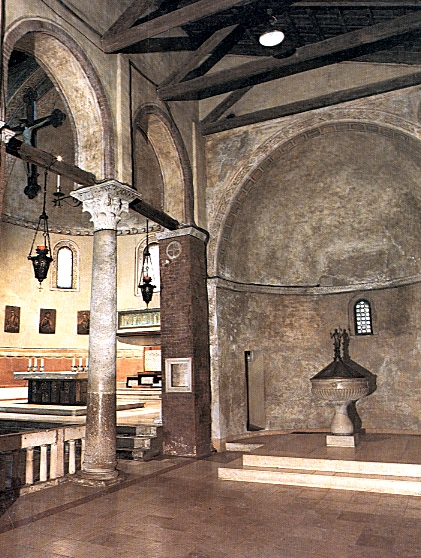The Cathedral - Nave Right

Now it is necessary to retrace our steps to visit the opposite aisle on the right.
There are still bears in the central door.
The holy water, on the right, consists of marble vase of Roman origin, placed upside down on a Corinthian capital, of unknown origin, in a solution almost identical, which is also observed in Santo Stefano di Venezia.
On the right side you look at the gilded wooden statue of the Assumption, tardocinquecentesco work;
Then the painting of St. Peter the Apostle in the waves, the anonymous work of the late sixteenth century, attributed to Titian, but without foundation, in obvious function caorlotti protector of fishermen and seafarers.
Then again the canvas of St. Sebastian, an anonymous 1699, the patron saint against the plague, from the demolished church of S. Rocco.
Along the nave has been observed in the late seventeenth century I'altare Wall St. Andrew the Apostle, specifically in Caorle of worship, as the patron saint of fishermen, peculiar activity of the inhabitants in the long centuries of their history, and prevalent even today.
Then in the wall the canvas triptych with St. Roch, Vincent diac. and Margaret, anonymous, but obviously the Venetian school, perhaps Belluno, in mid-eighteenth century.
The three saints are associated together, two of which, Rocco and Margaret, are patrons, the first against the plague and maybe even the second, though it was his precise COMPI to protect against the diseases of women.
But the holy places also reminds S. Margaret, now close to Caorle and marina and tourist center.
Tien I'ampia behind the wall painting of the Last Supper, the work of Gregorio Lazzarini, master of Tiepolo, executed in 1672 and signed by the author.
The stool in the foreground bears the emblem of canonical Bon I'ha donated.
On the wall is also admire the painting of St. Ritada Cascia, performed in 1955, commissioned by archpriest Mgr.
Marchesan, the discreet Venetian painter Marco Novati.
Tien behind a fresco by anonymous mid-seventeenth century, with stories of S. Lucy of Syracuse, valuable for the historical record of Caorle there presents the background as the cathedral and bell tower.
On the sides are held in rhythm sequence the key events of the saint's life in faithful obedience to the data of its second acts pdssio Greek (not Latin, note) of his martyrdom.
In the boxes to the left and then upwards towards the right is the sequence of episodes of sick mother, the pilgrimage to the tomb of St. Agate for healing, the saint who rejects profertè double its presence before the Roman prefect, condemnation, fire, his last communion.
The whole is framed by a series of floral motifs separated by a heron and the top, bottom, by a rooster.
The author is anonymous, the popular taste, inspired by engravings. High up on the wall, overlooking the tomb of Daniel Tipper century 'de Rossi, bishop of Caorle (1513-1538).
Before entering all'absidiola background, we consider in the spandrels of the arch the remains of a sixteenth-century fresco with the scene of 'Ainnunciazione.
I'absidiola is located within the font, dated 1587, already existing in the church of S. Maria delle Grazie Medieval baptistry or outside near the main gate entrance, destroyed in the Napoleonic period.
It was saved only for practical purposes the baptismal font moved here.
 More info - The cathedral outside
More info - The cathedral outside
 More info - The cathedral inside
More info - The cathedral inside
 More info - The cathedral nave right
More info - The cathedral nave right
 More info - The cathedral nave left
More info - The cathedral nave left
 More info - Cathedral the presbytery
More info - Cathedral the presbytery


